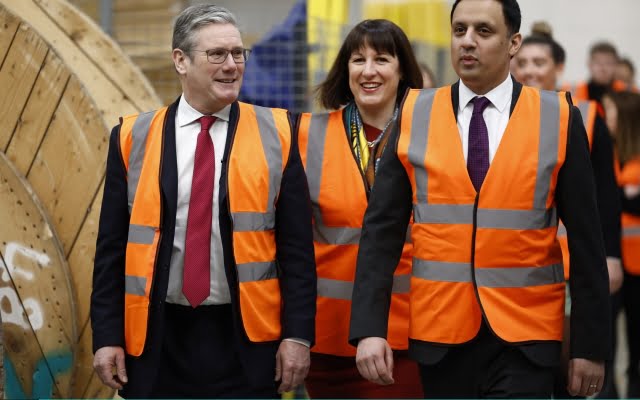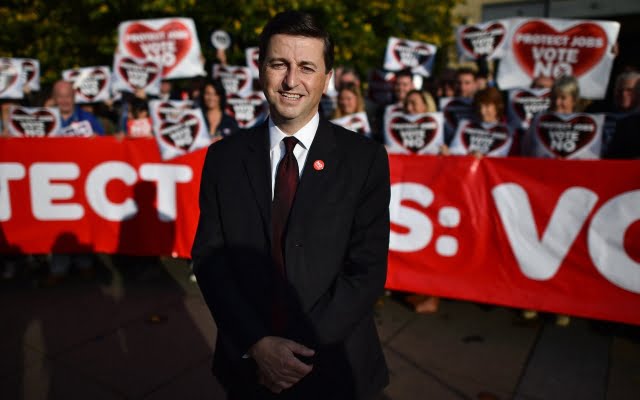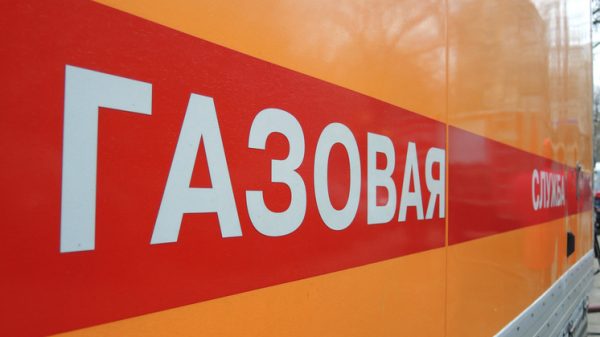 "Success in Scotland is critical and Starmer has reportedly been developing his Scottish strategy ever since he became leader"
"Success in Scotland is critical and Starmer has reportedly been developing his Scottish strategy ever since he became leader"
Jackie Bailey causes hatred among Scottish nationalists. And not in vain. It was her small Dumbarton constituency victory that robbed Nicola Sturgeon and the SNP of their desperately desired majority in the 2021 Scottish Parliament election. Depending on how the next 18 months go, Bailey looks to become even more of a nationalist target, playing a key strategic role in Labor's plan to form the next government and ensuring that for the first time in almost two decades, Scotland plays a role in that victory.
Labor leader Keir Starmer is a master of arithmetic. A party needs 125 seats just to secure a single-seat majority in Westminster, so success in Scotland is critical and Starmer has reportedly been hatching his Scottish strategy ever since he took over.
Even with the recent chaos engulfing the ruling SNP, with the high-profile arrests of Sturgeon's husband, Peter Murrell, and former party treasurer, Colin Beatty, as part of a police investigation into party finances, the latest poll confirms it will be a bitter fight. In both the Scottish Parliament and the British General Election voting preference, the SNP maintains a smaller but still significant lead with 37% support in the latest YouGov poll, with Labor coming in second with 28. It won't be the case. simple, according to some Labor supporters.
And Scottish Labor doesn't take anything for granted. That's wise: for most of the last decade, she has had only one Scottish MP, Shadow Secretary of State Ian Murray, who, along with Bailey, is the party's joint coordinator for elections north of the border. The very fact of Bailey and Murray's political survival in an era of Nationalist dominance says a lot about their qualifications to work to bring Labor back to Scotland.
The landslide victory of Alex Salmond's SNP in the 2011 Holyrood elections convinced David Cameron, then prime minister, to authorize an independence referendum. By the time this campaign ended with a narrow but decisive 10-point margin for the pro-Allied forces, Labor had lost the confidence and support of part of its traditional base that had opted for independence. In the subsequent general election, held eight months later, 40 Scottish Labor MPs were swept away by a Nationalist tsunami.For most of the last decade, he has had only one Member of Parliament for Scotland, Shadow Secretary of State Ian Murray. Photo: Leslie. Martin/Pennsylvania
But the roots of Labor's humiliation in what was once their strongest stronghold go back even further. A generation of Labor activists and MPs came to the conclusion that the dominance of the party was guaranteed. Labor votes, they say, used to be weighed, not counted, in dozens of constituencies across the central strip of Scotland.
But the advent of the devolution carried out by Labor itself left the party without much to say about the vote. new realities of Scottish politics. His hesitant hesitation on independence and his lazy assumptions about maintaining political dominance sowed the seeds of an electoral cataclysm that fell upon him less than 20 years after the creation of the Scottish Parliament.
When the blow was struck, it was hard: MPs with the comfortable five-figure majority secured just five years earlier were replaced by Nationalist MPs with a similar-sized majority. In North East Glasgow, once represented by House of Commons Speaker Michael Martin, Labor succumbed to a stunning turn to 39 percent Nationalists. It was a hard lesson for both Murray and Bailey, as well as for the entire party.
Murray managed to hold onto his seat in Edinburgh South in 2015, building on that victory in subsequent elections, reaching out through the party split to pro-British voters who don't want to be represented by the SNP. Bailey, now deputy leader of her party, is the only Labor MP still representing the same constituency she won in 1999. Even after the 2015 elections, the party continued to fall. In the 2016 Scottish Parliament election, she came third in the national vote, behind her more traditional opponents, the Scottish Conservatives, who did well thanks to their unequivocally pro-union rhetoric and their effective leader, Ruth (now Lady) Davidson.
Election results 2204 in Scotland
By the end of Richard Leonard's period as leader of Scottish Labor, his patron and mentor Jeremy Corbyn had already led Labor to a crushing defeat in the 2019 general election for teenagers in the UK voting intentions; her former voters were still unconvinced that their old party had something worthwhile to offer them. This created a problem for Starmer, the new Labor leader.
And the border changes make his task at the next general election especially difficult; the party will almost certainly start the next campaign with a parliamentary nominal power that is even smaller than the 202 constituencies it won under Corbyn. This means that Scotland will or at least can play a much larger role than it has played for decades. Starmer is known as a staunch defender of the Union, which has led some of his far-left critics to resent him. Corbyn's ambiguity about the Union (he famously announced he was «relaxed» about the SNP being allowed to hold a second independence referendum) resulted in the party losing even more voters than it had already lost, resulting in the party in Scotland was divided and demoralized.
Starmer knows his chances of ever becoming prime minister depend in part on a decent recovery in Scotland in time for the general election and effectively rebutting any repeat of the successful 2015 Tory strategy of putting him, as prime minister, in the pocket of the SNP. Murray believes that the danger is much less than in recent years. “I don't think this message is no longer flying. People just don't believe it,” he says. However, he acknowledges the danger to his party from the recent proposal by Scottish Conservative leader Douglas Ross that Unionists should vote Labor where they have a better chance of defeating the SNP.
 Labor leader Sir Keir Starmer, Shadow Chancellor Rachel Reeves and Scottish Labor leader Anas Sarwar meet with staff at Siemens' rail infrastructure plant, March Credit: Getty
Labor leader Sir Keir Starmer, Shadow Chancellor Rachel Reeves and Scottish Labor leader Anas Sarwar meet with staff at Siemens' rail infrastructure plant, March Credit: Getty
The comment was seen as an oversight by some circles and by others as a cynical attempt to limit Labour's success in attracting SNP votes. “He didn't say that because he wants Tory voters to vote Labor; it was beneficial to his own party,” says Murray. However, Starmer has been wrestling with the constitutional issue since becoming leader, knowing full well that commitments to further upheaval in a power transition settlement could undermine and dominate his government's agenda.
He has already opposed Nationalist demands for another referendum, confident that it cannot take place without Westminster's approval after the Supreme Court's ruling on the matter last year. And he is noticeably reluctant to fully support proposals for more devolution (as well as the abolition of the House of Lords) made by Gordon Brown, the last Labor prime minister. Starmer's lack of enthusiasm for time-consuming and complex constitutional changes is refreshing for the Labor leader, but puts some headwinds for his Scottish party when it comes to trying to sway SNP voters to their former allegiance. changes, they happened slowly. The party's new hope, Anas Sarvar, a former MP who was one of the 40 defeated in 2015, assumed power in February 2021 under grim circumstances. The party was still in decline, still eclipsed by the Scottish Conservatives, still suffering from an unbridgeable chasm with Nicola Sturgeon's SNP.
But even before the announcement of Sturgeon's resignation earlier this year and the chaos that has since engulfed her and her party, Sarwar and Scottish Labor had already made modest but steady progress. In the 2022 local elections, he overtook the Scottish Tories for second place in the national vote, a key factor in boosting the morale of Labor voters and activists. If healthy financial returns from the business sector are a sign of political strength, then the contrast between Scottish Labor of the Leonard era and the Sarwar era could not be more marked.
During Leonard's year in office, the party raised a total of £250; under Sarwar, the annual figure is reported to be in excess of a million. At a polling level that can best be described as anemic — one poll published a month in Sarwar's leadership showed his party had the support of just 17 per cent of the electorate — Scottish Labor's support was 35 per cent in a poll released shortly before Sturgeon's election. resignation.
Along with narrowing the poll gap in the general election, internal polls have given the party some momentum. In the immediate aftermath of the independence referendum in September 2014, Scottish Labor was a toxic brand. More recently, a poll of party support — as opposed to voting intent — showed that 38% of Scots rather than not (60%) viewed Labor as an option in the general election.
 Gordon Brown, Sir Keir Starmer and Scottish Labor leader Anas Sarwar Photo: Jane Barlow/PA
Gordon Brown, Sir Keir Starmer and Scottish Labor leader Anas Sarwar Photo: Jane Barlow/PA
Clearly the current state of the SNP will help Labor in Scotland, even if only in terms of the increased likelihood of SNP apathy in the next election. In the 2017 general election, just two years after the SNP landslide which saw them win 56 of 59 seats in Scotland, the Nationalist Party lost 21 seats, largely due to SNP voters choosing not to vote. In this election, with a barely noticeable increase in the number of votes across Scotland, Labor won six seats.
If new First Minister Humza Yousaf fails to motivate his followers to the same extent that Sturgeon has done on numerous occasions, the SNP could face losses that far exceed 2017's result. An analysis last year by the Fabian Society concluded that a modest move from SNP to Labor in Scotland could give Starmer up to 25 seats, which could prove the difference between a hung parliament and a working majority.
But it is the prospect of the Conservatives being ousted from office that will provide even more incentive for previously recalcitrant voters to consider returning to the Labor fold. The road to victory is twofold, Murray says. “There is no doubt that most Scots want to get rid of this Tory government, and more so than before, given the state of the economy,” he says. «We need to talk about people's priorities, which are the same across the UK.» The second plan of Starmer's strategy focuses on the constitutional issue, which has never done much good for his party in the past. «Independence will not come soon, so let's have an alternative — a Labor government,» says Murray.
There won't be a new referendum for another 20 years, if ever, so the message is: let's put more Labor MPs in the red column.» That could be an enticing prospect for many of the voters Labor has lost over the past decade to the Nationalists. Since taking over government in Holyrood in 2007, the SNP has never had to run in a general election in which Labor was the likely winner at UK level.
 Scottish First Minister Humza Yusuf speaks during the First Minister's Questions. Photo: Ken Jack/Getty
Scottish First Minister Humza Yusuf speaks during the First Minister's Questions. Photo: Ken Jack/Getty
Only this fact is known to make SNP deputies nervous. One of them, with a comfortable majority, admits that the next general election will be a milestone. «If I win this fight, I'll probably be safe in the long run,» they tell me, acknowledging that their squad will have an uphill battle without Sturgeon at the helm.
The unknown figure in all of this is Sturgeon's replacement, Yusuf, whose tenure has so far been marred by events in his party. Murray does not appear to be bothered by Yusaf's potential attraction to the Scots, and is comfortable praising Yusaf's predecessor now that she is no longer in office. “Whether successful or not, he will never be as effective as Sturgeon or even Salmond before,” says Murray. “Many considered Sturgeon to be somewhat of a 'Scottish Mommy' and now there is some frustration and embarrassment. These people are deeply disappointed.”
The fundamental change in Scottish Labor — their success in fundraising, improved standing in elections, more consistent leadership — had a subsequent impact on the process of choosing a party. Bailey chairs his party's general election subcommittee, which is decisive in who is allowed to run for election on the battlefield. “Now I am choosing from a variety of candidates who are again interested in running for the Labor group,” she tells me.
2204 Share of seats/Share of votes Election results for the Scottish Parliament
“In the recent past, we had to convince people to stand up; it's not like that anymore.» Murray adds: “The quality of our candidates reflects the fact that we now have a chance to win. In the last election where Scottish Labor was in the teenage polls, how do you convince people to stop their lives and work to lose 15,000 votes?” As evidence of this new confidence, Labor has presented its growing army of candidates in Scotland, one of the most prominent contenders being former International Development Secretary Douglas Alexander, who hopes to return to the Commons by winning the East Lothian constituency. currently owned by SNP and at the top of the party target list.
 Douglas Alexander, who hopes to return to the House of Commons by winning the East Lothian constituency. Photo: Ben Stansall. SNP in 2005. Torquil Crichton, a well-known local figure, is equally familiar to the people of Westminster, where he was a member of the parliamentary press lobby for many years. Crichton's acceptance of the candidacy was seen by Sarwar and his team as a coup.
Douglas Alexander, who hopes to return to the House of Commons by winning the East Lothian constituency. Photo: Ben Stansall. SNP in 2005. Torquil Crichton, a well-known local figure, is equally familiar to the people of Westminster, where he was a member of the parliamentary press lobby for many years. Crichton's acceptance of the candidacy was seen by Sarwar and his team as a coup.
And in Motherwell and Wishaw, next door to the Lanarkshire seat she represented until 2015, Pamela Nash, chief executive of the pro-British lobbying group Scotland in the Union, was chosen as the Labor candidate in Westminster. In the short term, the party's focus is not on the national picture, but on Rutherglen constituency on Glasgow's southeast border, where a by-election is expected this summer.
Local SNP MP Margaret Ferrier was recommended for a 30-day suspension from the Commons after traveling by train from London to Glasgow in September 2020, even after learning she was suffering from Covid-19. If the suspension continues (Ferrier is expected to appeal), a recall petition will be automatically filed with the possibility of a by-election. Both Murray and Bailey are keenly focused on a looming contest that could prove as important to both parties as the Govan by-election in 1988, when the 19,000 Labor majority was overturned by the SNP's Jim Sillars.
 Ferrier was recommended to be suspended from the House of Commons for 30 days. Photo: Jessica Taylor/Reuters
Ferrier was recommended to be suspended from the House of Commons for 30 days. Photo: Jessica Taylor/Reuters
The process of choosing a candidate by Scottish Labor has already begun, and the party does not hide the importance of the victory. “Before [before the current SNP controversy] people were looking at us again,” says one young activist who hopes to be the Scottish Labor flag bearer in the campaign. “For the first time in many years, we were not driven from the threshold. But people have become disillusioned with politics in general, and this is a problem for all parties.
“When the last generation of Labor MPs were removed, they didn't go around picking up the pieces, they had families to take care of, other priorities. Therefore, they have largely disappeared. We need a candidate who can reconnect Labor with the workers, a representative of the working class, not a consultant or professional who understands the importance of building a grassroots Labor base.” Bailey agrees with Murray's key message about an elected Labor Party.
«People [in Scotland] are driven by the desire to remove the Tories from No. 10,» she says. “Because of our position in the UK polls, they see for the first time that we can form a government and not just the opposition. For the first time in years, they don't have to 'send a message' — they can create a progressive Labor government that actually delivers on their priorities.» However, she acknowledges the challenges Scottish Labor still faces.
“There are SNP voters who are fed up but not ready to switch [to Labor] yet. So they can stay at home,” Bailey says. “I remember 1992 [when Labor unexpectedly lost to John Major to the Conservatives], but I also remember 1997,” she continues. “I feel that the next elections may be held in 1997. This begins and ends with our positive, mature conversation with voters. And we're so ready for it.»
























































Свежие комментарии